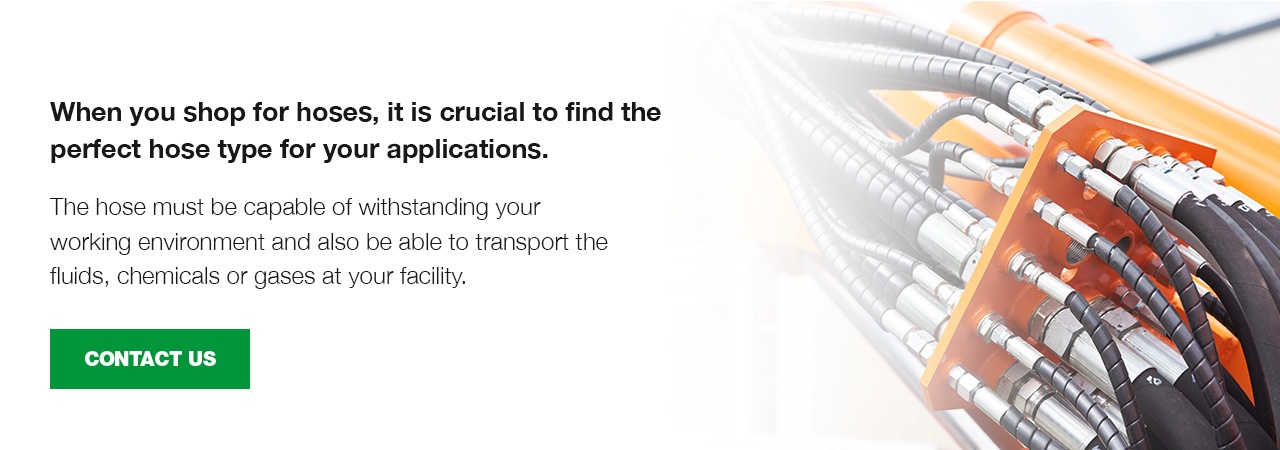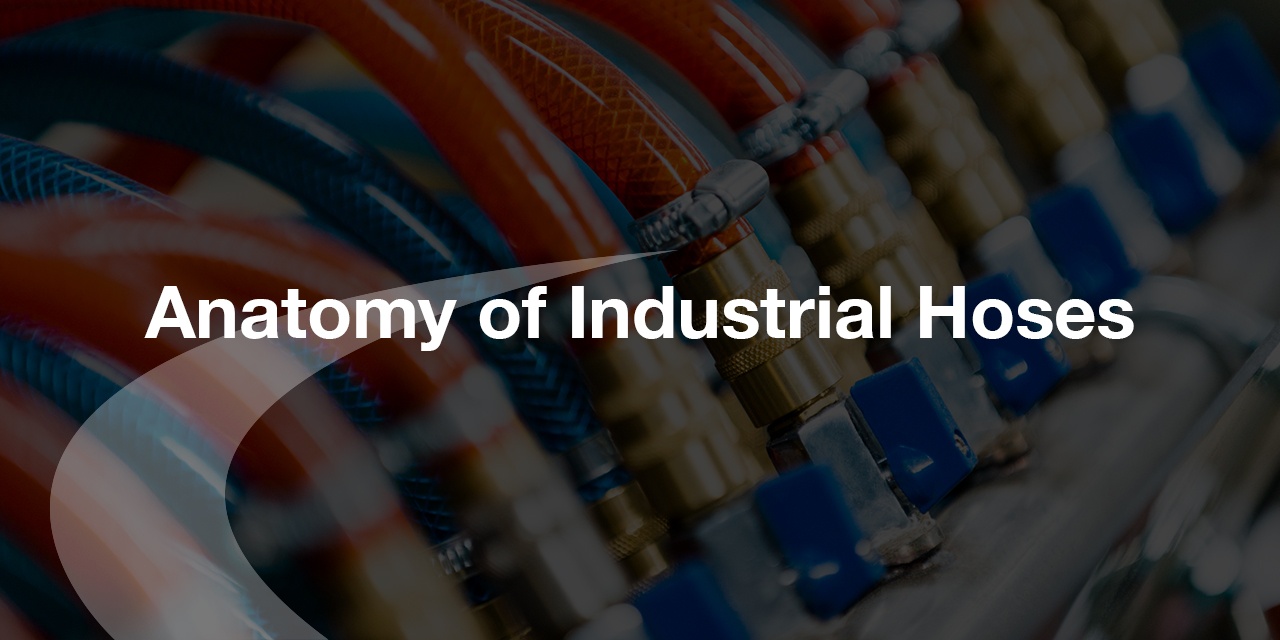
Have you ever thought about the contents of the various hoses in your industrial arsenal? Did you know there is more than one material contained in each hose? Yes, various elements each contribute to the unique composition, strength and makeup of a given hose. These materials help make hoses strong and durable for their intended functions in different factory settings.
The types of materials that go into a given hose’s composition will typically determine its style. A particular design usually matches select coupling parts with specific tolerances.
Two hoses from different makers will often have similar design characteristics, but contain varied materials. While you might mistake the two hoses as coming from the same brand, factors such as performance and durability might not line up between the two. If one hose fails while the other remains robust, it could all be down to their material differences.
When it comes to hose construction, each manufacturer uses a different mix of ingredients. Even when you have two hoses with the same intended purpose, they will likely perform differently if they come from competing manufacturers.
Layers of a Hose
Over the past few decades, the basic principles of hose design have mostly remained the same. Even as new materials and components have entered the scene, hose design still centers on three fundamental parts.
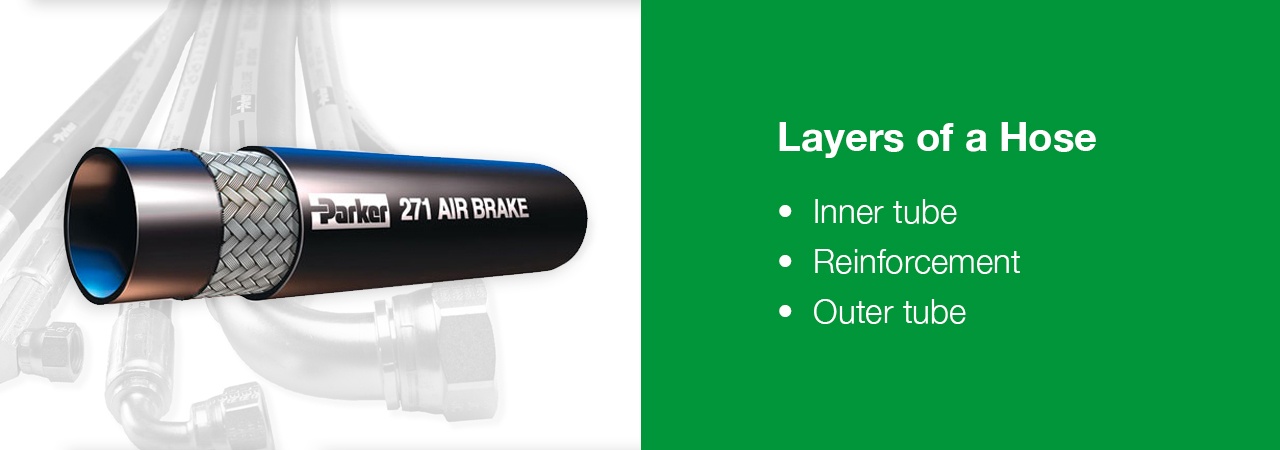
- Inner tube: The inner layer of a hose that makes contact with passing fluids and gases
- Reinforcement: The coating between the inner and outer layer
- Outer tube: The outer layer of a hose that you see and handle
If you need a hose to handle specific fluids and gases, the inner layer will be the crucial component. Based on the material composition of the interior layer, a given hose may or may not be adequate for the functions you have in mind.
If, for example, you need to use a hose to carry a particular fluid between two points in your industrial system, the inner layer will need to consist of chemical compounds that can handle that fluid. In some hoses, the inner layer could be chemically insufficient for the fluid in question. If exposed, it might swiftly erode and cause catastrophic hose failure.
The Inner Layer
Each compound included in the inner layer of a hose could have a different reaction to any given type of fluid that passes through. Therefore, you must ensure all the compounds in a particular hose are compatible with the fluid or gas that you intend to pass through it. For example, if you plan to use a hose to carry hot liquids, each compound within the inner layer will need to have the strength to withstand heat.
Inner layers usually consist of various rubber types, such as synthetic rubber, PKR rubber, EPDM rubber and butyl rubber. PKR rubber is one of the essential compounds for most industrial hoses because it withstands petroleum fluids. It also has the strength to hold up to weathering caused by air exposure.
EPDM rubber is another essential compound in a vast range of industrial hoses. EPDM, which stands for ethylene propylene diene monomer, is a base polymer that has the strength to tolerate a variety of liquid temperatures. It can also handle fireproof hydraulic liquids. EPDM rubber has sufficient strength for high heat levels and weather exposure. Its composition and flexibility remain unchanged through extreme changes in temperature.
Synthetic rubbers are ideal for handling a range of fluids, including petroleum-based fuels and green-based fluids. The two central compounds in synthetic rubber are nitrile and ACN. Nitrile gives the rubber its ability to handle hydraulic fluids and oils.
ACN, or co-polymer of acrylonitrile, is what gives the synthetic rubber its fluid resistance. You can render a synthetic rubber even more resistant to fluids by increasing the amount of ACN used in the rubber. However, doing so will reduce the rubber’s flexibility and make it more prone to crack over time. The problem could become worse in settings where the hose is subject to vast changes in temperature, as this causes flexing.
Butyl rubber offers excellent resistance to weathering but is weak at handling petroleum-based fluids. Therefore, you wouldn’t want to use a hose with butyl in its inner layer if you plan to use that hose to transfer petroleum-based oil or gasoline between two or more machines in your factory. Still, a hose that contains butyl rubber in its inner layer could be sufficient if you plan to use the hose to pump air through different tools.
The Reinforcement Layer
When it comes to the strength of a hose, the reinforcement layer is crucial. The reinforcement surrounds the inner layer and gives the hose its physical resilience. Without the reinforcement layer, the hose would likely rupture if forced to withstand high volumes of pressure.
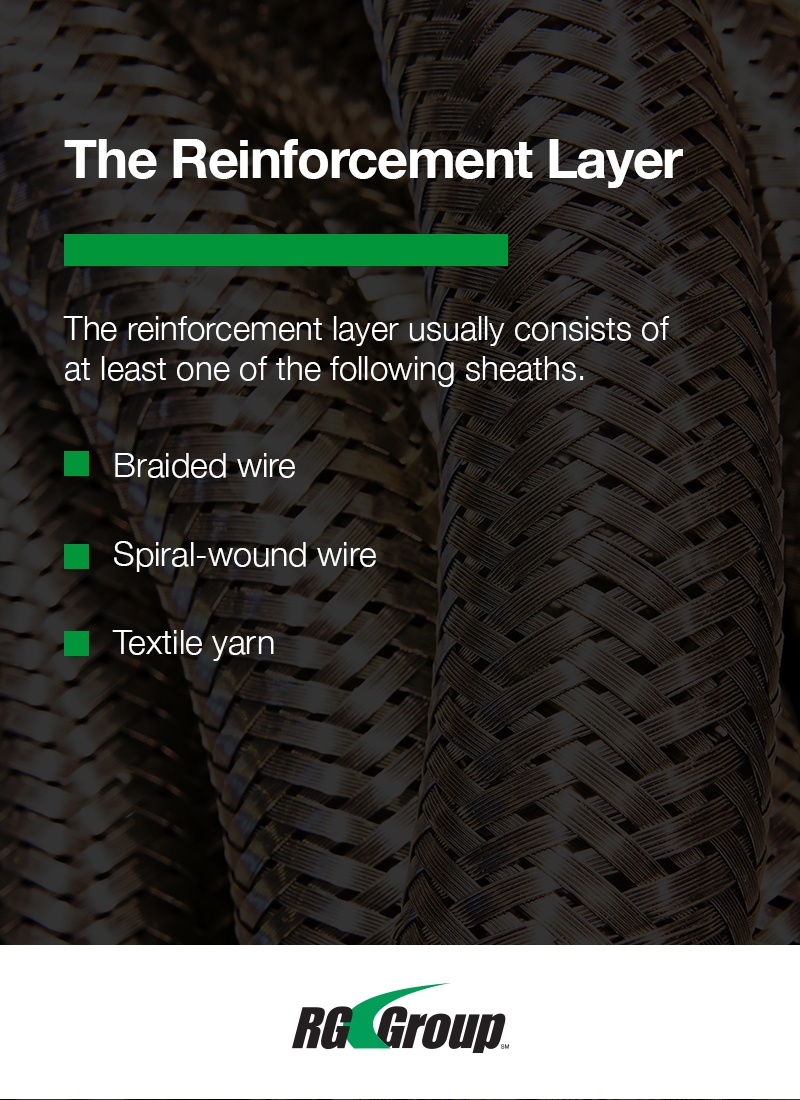
The reinforcement layer usually consists of at least one of the following sheaths.
- Braided wire: Makes the reinforcement layer flexible, yet pressure-resistant, and renders the hose suitable for select applications
- Spiral-wound wire: Used in hoses designed for critical applications that involve high volumes of pressure
- Textile yarn: Used in flexible hoses designed for low-pressure applications
The strength of the reinforcement layer could protect your facility from an emergency if the inner layer fails while a hose is in use.
The Outer Layer
From an outside perspective, the outer layer is the central component of each hose in your facility. This part must withstand external factors and the elements. The outer layer protects the reinforcement layer from moisture, dust, heat, rain and other outside forces.
Depending on the environmental factors at play in your industrial setup, you might need your hoses to have extra-strength outer layers. Depending on the type of hose and its intended purpose, it might have a high- or low-grade cover.
Many manufacturers label their hoses based on the strength of the cover. For example, one hose will list a standard cover, while another will list a tough cover, indicating that the latter is several times stronger.
The outer layer could end up prolonging the life of a hose in settings where the heat or moisture would damage the reinforcement layer. If an accident occurs that would cut through the reinforcement layer on contact, the outer layer would be the only thing saving the hose.
Hydraulic Hoses
Hydraulic hoses send fluids between different components in a hydraulic system. Examples of such components include actuators, hydraulic tools and valves. The hydraulic hose is usually flexible, yet durable. It generally consists of materials that allow it to bend and wrap around specific components if necessary, but also resist stress and withstand impact.
Hydraulic hoses have several layers of reinforcement to withstand the abrupt changes in operating temperature that characterize a typical hydraulic environment.
A vast array of industrial applications use hydraulic hoses, including anything that involves the transfer of water from one point to another. The central factors in hydraulic hose design include the dimensions of the inner and outer layers and the material that goes into each layer.
When you select a hydraulic hose, make sure the inner and outer diameters are sufficient for your intended use of the hose. Also, take note of the minimum bend radius, as this will indicate whether the hose is adequately flexible for your hydraulic setup.
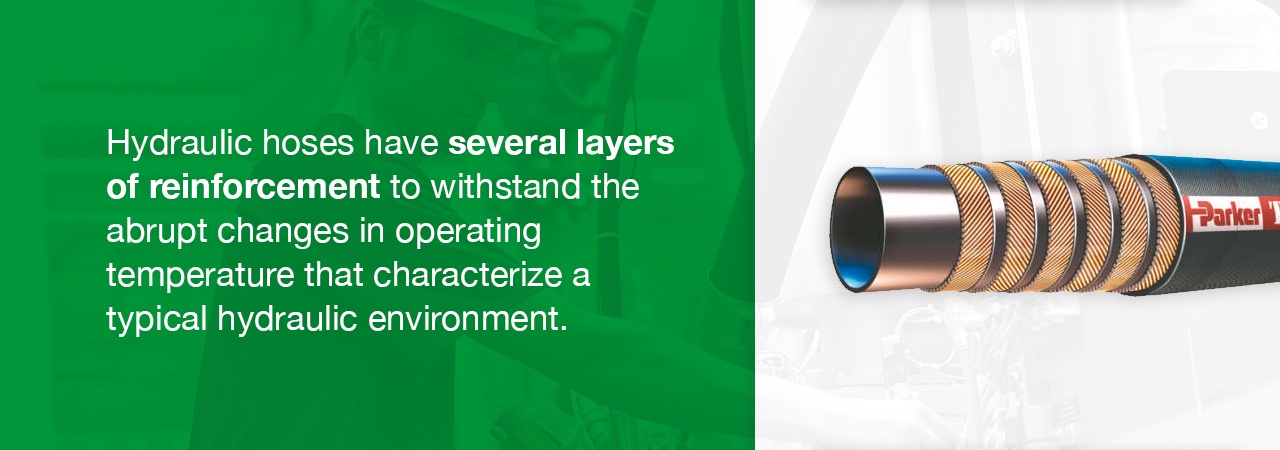
Hydraulic hoses come in several basic designs. A reinforced hose features wires that enhance the strength of the rubber. These reinforcements, which include wire braid and helix, are crucial in work settings where environmental factors could easily damage the rubber.
The most flexible design is the coiled hydraulic hose, which can roll out on work shifts and curl up when not in use. The coils expand the hose’s elasticity and flexibility. This type of hydraulic hose is especially convenient in tight industrial setups that require it to fit around several angles.
Another flexible option is the corrugated hydraulic hose, which features wrinkles or pleats that let you expand or roll up the rubber as needed. The creases make it natural for the hose to fold when it is not in use to connect between different components at your plant.
Of all the different types of hydraulic hoses, the one with the most complex design is the multi-element hose. These consist of two or more hoses joined in a ribbon or bundled design.
Before you buy a hydraulic hose, take note of its end connections. Will they attach correctly to the components in your arsenal? Is it anti-static and flame-resistant? These qualities are crucial in any industrial setting. Check, also, to see whether the hose has undergone testing against high impacts and stresses.
With all these considerations taken into account, the foremost factor to note is the composition of the hose and its three layers. Does the hose consist of materials that can withstand the fluids you intend to send through it each day?
If you are buying the hose to send chemicals between points A and B in your factory, make sure that the materials that constitute the inner rubber can handle these chemicals. Substances like salt, pollution and ultraviolet light can all damage various rubbers. To verify the fluid compatibility of a given hose, ask the manufacturer before you finalize your purchase.
Hydraulic hoses typically consist of a mix of materials, including thermoplastics, elastomers, silicone, fluoropolymers, composites and metal. The most flexible hydraulic hose components are usually elastomer and rubber.
Some of the more durable hoses use fluoropolymer, which withstands exposure to chemicals, corrosive elements and high intensities of heat. Metal hoses are also impervious to high temperatures. While these can come in flexible and rigid varieties, metal hoses lack the flexibility of their rubber counterparts.
It’s crucial to note that hydraulic hoses are not interchangeable with industrial hoses.
Industrial Hoses
Industrial hoses serve a vast range of purposes, including chemical, air and food delivery. Depending on your industry, you might use hoses for various components in your industrial arsenal. For example, an air hose will let you transport oil, chemicals and air between two different machines. If you have an air compressor, the air hoses will connect it to your pneumatic tools. Industrial hoses can also safely transport acids, solvents and other chemicals. With a chemical hose, you can transfer substances that might be dangerous to transport any other way. Chemical hoses have inner materials, such as formulated polyethylene, that withstands the effects of the active ingredients.
Industrial hoses are standard in the food and beverage industries, which requires transportation of liquids and fillings between mixing machines and product containers. The industrial hoses used in these factories typically consist of stainless steel mandrels, as these prevent the spread of odor and aftertaste from the hoses to the food containers.
In the petroleum industry, industrial hoses transport products such as diesel, ethanol, gas and biodiesel. For the steam industry, hoses can withstand intense heat and moisture saturation. Hoses of these sorts contain oil and resist cracking.
In oil fields, industrial hoses transport petroleum waste and crude oil.
You can also use industrial hoses for applications such as gas welding, which relies on fuel gases like nitrogen, propane, propylene and natural gas. If you need a twin configuration, color-coding the hoses helps with engineering purposes and cuts down on staff confusion.
Abrasion-Resistant Hoses
The majority of industrial hose manufacturers deal exclusively with rubber hoses.
Unlike automotive hoses, which are subject to industry standards, no such guidelines exist for industrial hoses. Consequently, you’ll find many industrial rubber hoses cobbled together from parts made by different manufacturers.
The exception is Parker hoses, which the company tests with couplings from various manufacturers. With Parker abrasion-resistant hoses, you can get guaranteed quality for your industrial applications.
With an abrasion-resistant weld hose, you can gas-weld with a variety of fuel types. The hose will withstand prolonged exposure through a range of temperatures because the inner layer of the hose consists of suitable materials.
You can also get more mileage with an abrasion-resistant hydraulic hose, which should be able to transport fluids within various environmental settings. Whether you operate in a hot or cold environment, the hydraulic hose should resist abrasions regardless of all the external factors.
When you shop for hoses, it is crucial to find the perfect hose type for your applications. The hose must be capable of withstanding your working environment and also be able to transport the fluids, chemicals or gases at your facility.
RG Group carries a variety of abrasion-resistant hoses from Parker. Additionally, we sell a selection of complementary products, whether you need a splicer or an abrasion-resistant hose sleeve. Explore the RG Group catalog today and contact our product experts to learn more about our available industrial hoses.






